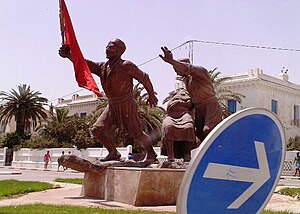Enfidha
Enfidha
دار البي Dar-el-Bey | |
|---|---|
 Enfidha - square | |
| Nickname: Henchir Chigarnia | |
| Coordinates:36°8′7″N10°22′51″E/ 36.13528°N 10.38083°E | |
| Country | |
| Governorate | Sousse Governorate |
| Delegation(s) | Enfidha |
| Government | |
| •Mayor | Abdellatif Hamouda(Independent) |
| Population | |
| • City | 11,138 |
| •Metro | 49,335 |
| Time zone | UTC1(CET) |
Enfidha(orDar-el-Bey,Arabic:دار البي) is a town in north-easternTunisiawith a population of approximately 10,000. It is visited by tourists on their way toTakrouna.It lies on therailwaybetweenTunisandSousse,approximately 45 km northeast of Sousse and a few kilometres inland from theGulf of Hammamet.The nearbyEnfidha – Hammamet International Airportopened in 2009, serving charter flights from severalEuropeancountries.
History
[edit]Ancient history
[edit]NearbyHenchir Chigarniais anArchaeologicalsite and formercivitasof theRoman ProvinceofAfrica Proconularis.
About 8 km north of Enfidaville is anotherRomansiteHenchir Fraga,which is the ancient town ofUppenna,whereruinsinclude a largefortressand of achurchin which were foundmosaicswithepitaphsof variousbishopsandmartyrs.[1]ThebishopricofUppennahas been brought into use as aRoman Catholictitular seesince 1967.[citation needed]
Early Modern History
[edit]The Enfida estate was granted by thebeyMahommed-es-Sadokto his chief minister,Khaireddin Pasha,in return for the confirmation by thesultanofTurkeyin 1871, through the instrumentality of thepasha,of the right of succession to thebeylikof members of Es-Sadok's family.[1]
French Colonial Era
[edit]When Khaireddin leftTunisiaforConstantinoplesome years later, he sold the estate to aMarseillecompany which named itEnfidaville.The attempt by the Tunisian authorities to block the sale of the estate to aFrenchbuyer is regarded as a contributory factor in the decision of the French government to bring Tunisia under colonial rule. The estate was later sold on to the Société Franco-Africaine. Enfidaville became the chief settlement on the Enfida estate, a property of over 300,000 acres (1,200 km2) in theSaheldistrict of Tunisia, forming a rectangle between the towns ofHammamet,Sousse,KairouanandZaghouan.On this estate, devoted to the cultivation ofcereals,olives,vinesand to pasturage, were colonies of Europeans and natives. At Enfidaville, which was, as its native name indicates, a palace of thebeysof Tunis, came a largehorse-breeding establishment and a much-frequented weekly market.[1]
World War II
[edit]Enfidaville was the site of the last battle in theNorth African CampaignofWorld War II,and was the site of an AlliedAirfield.
In April 1943 duringOperation Strike,theAmerican Corps IIcornered theAxis powersforce against the Tunisian Coast. The BritishEighth Armyattacked Enfidaville on 19 April captured the village, but met strong resistance. Attacks further north saw the fall ofTunison 7 May, to theBritish First ArmyandBizertaon 8 May to the Americans. Resuming the assault on Enfidaville on 11–13 May, the city saw the defeat of Axis forces but with significant casualties. 1,551 Allied casualties were buried in the Enfadaville War Cemetery,[2]including Wing CommanderIan GleedDSO DFC, an English RAF pilot andflying ace,who was shot down overCap Bon.[3]
References
[edit]- ^abcChisholm 1911.
- ^"Enfidaville War Cemetery".www.cwgc.org.Commonwealth War Graves Commission.Retrieved4 February2018.
- ^"Battle of Britain London Monument - F/Lt. I R Gleed".www.bbm.org.uk.Retrieved4 February2018.
- This article incorporates text from a publication now in thepublic domain:Chisholm, Hugh,ed. (1911). "Enfidaville".Encyclopædia Britannica.Vol. 9 (11th ed.). Cambridge University Press. p. 403.
- Catholic Hierarchy
External links
[edit] Media related toEnfidhaat Wikimedia Commons
Media related toEnfidhaat Wikimedia Commons

